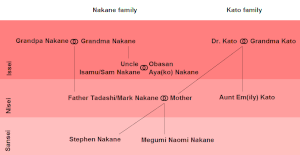| This image shows the family tree of Noami, the narrator of Joy Kogawa's novel "Obasan". (Photo credit: Wikipedia) |
How did this story begin to develop? Its opening scene just showed up, Part I.
Part II of The Visitor is now on-line. The Visitor comes into the narrator's home again and is, still, "unchanged." The fact that the visitor accepts an unlikely invitation to dinner (E's idea) fails to indicate to the narrator the change she feels she must see and believe. Yes, the visitor sits at the dining table; she meets and eats with the narrator and her two sons and their families; and she sees the family "hall of fame," as one son calls it, without comment.
This time the visitor shows no sign of insistence that E is not the narrator's daughter, as she did the first time she came to the door, almost a stranger. And, there is no evidence that she holds it against the narrator that, on her second visit, she was not invited into the home again.
However, her presence at dinner this time, in the home, does not include any acknowledgment that Elizabeth, known as E by her family and a prominent neurosurgeon, is truly the narrator's daughter, as the narrator claims. Accepting E's family identity is the change that the narrator is looking for in the visitor.
I have
wanted from the beginning to form a puzzle, like a little mystery, in this short story. Whether or not the mystery hides something highly or
slightly significant is not yet clear. Two hints appear with Part II. One is visual and the other sits in the text. What will it take to solve the puzzle in the reader's mind? Perhaps Part III, not yet titled, will provide the answer. To solve the puzzle, the key question is about identity regarding one, single attribute. I wonder if any reader has guessed what that is. And why are we not told the narrator's or the visitor's names?
Alec Powers (c) 2012 - "I find the term 'psychological speculation' useful ..." (see When Nights Were Cold, below)



No comments:
Post a Comment